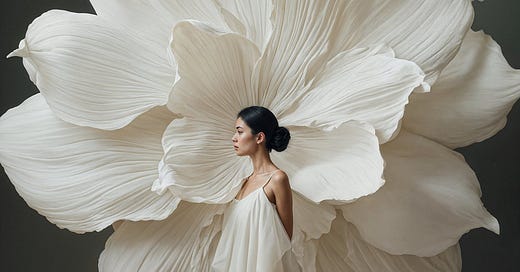A few days ago, I came upon a bloom.
A flower sprung from a rough cactus, standing in the middle of a California sidewalk, in the shadow of buildings and under the indifferent gaze of passersby. It seemed almost placed there by mistake, a soft anomaly, an improbable grace risen from the botanical world. A flower of brilliant white, silky, sunlit.
I stayed in front of it for a long time.
The silence around it was the right kind. So was the light.
Something, there, shifted in me, gently. Not a clear thought. More like an old memory, embodied, of a possibility I thought long gone.
Even if everything in me seemed dry, I had quietly kept the power to bloom.
I didn’t understand it at once. But the flower, without pressing, whispered it to me.
There was something strangely familiar in this encounter.
The contrast between the cactus’s rough skin and the corolla’s almost unreal softness wasn’t a contradiction. It was a kind of quiet logic, the kind biology knows well. That spiny stalk doesn’t only guard against thirst: it prepares, patiently, for what might open one day. And what opens then looks nothing like what bore it.
This apparent paradox appears in psychology too.
In the folds of painful experience, in the scar tissue of bruised lives, something unexpected can take shape. A new clarity. A capacity to feel. To adapt.
Researchers call it resilience. But what I witness here is more subtle. It’s not about bouncing back, but about changing. Quietly. Slowly. Until one day, a flower bursts from the end of a column of spines.
And before that bloom, there is the husk.
A dark, fibrous wrapping, somewhat rough, that I first mistook for a dried growth. It holds the budding flower, shelters it, waits for the right conditions. Botanically, it’s called a series of floral bracts.
Without that ungraceful protection - whose looks, truth be told, disturbed me - the flower couldn’t exist. It’s a survival strategy, a discreet scaffold that becomes the architecture of what’s next. And I can’t help but think of our own forms of protection, sometimes judged too dense, too dull, while quietly shaping something yet to come.
That moment, facing the cactus, reminded me of something essential: Just because a place seems dry doesn’t mean it’s no longer fertile.
Like many, I pass through spells where everything feels asleep: ideas, impulses, even joy. We think then that nothing is forming. But nature works otherwise. It moves in underground layers. It rushes nothing. It knows the weight of the right moment.
Something is taking shape. Not trying to be seen, but insisting on existing.
The beauty of true presence.
François Cheng, in his luminous letters on beauty, links the depth of a wound to the pull toward light. Beauty isn’t surface. It’s passage. It appears where life has held on, where it has continued, despite everything.
“Beauty is always a becoming, an advent, if not to say an epiphany… an appearing-there.”
And maybe this flower was only reminding me of that: Beauty doesn’t ask permission. It can rise from silence, without a plan. It doesn’t owe its presence. It doesn’t last, it’s true. But in its brief brightness, it shifts the real. It resets something in us. A direction. A readiness.
The bloom was brief. Just a few hours.
What makes cactus blooms so arresting is precisely that: their fleeting nature. They arrive with a kind of theatrical surprise, a gesture of defiance to the harshness of desert air, or the dry heat of cities.
By the next day, the corolla had already closed. The stalk stood still again. But the essential had happened.
It wasn’t about lasting. It was about appearing.
And in that appearance, the silent truth: Even what seems hardened, stuck, or forgotten can still, one day, offer itself to the light.








